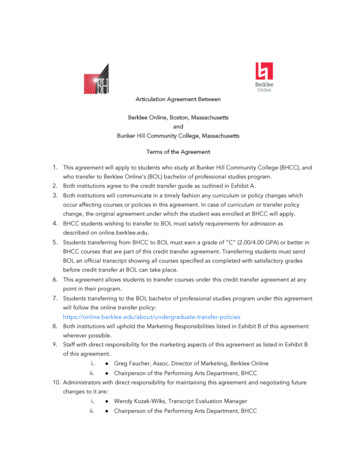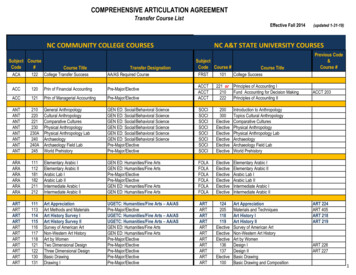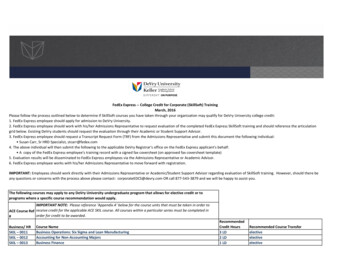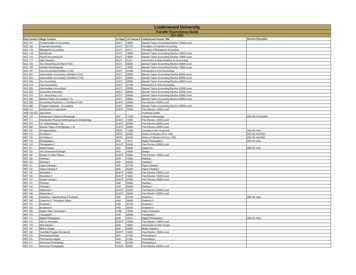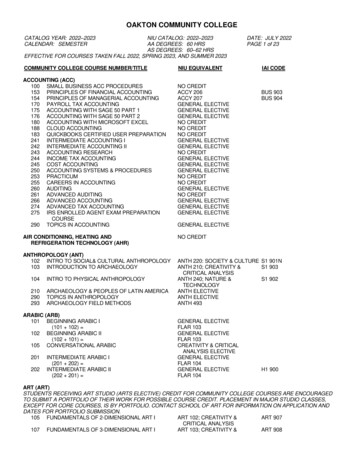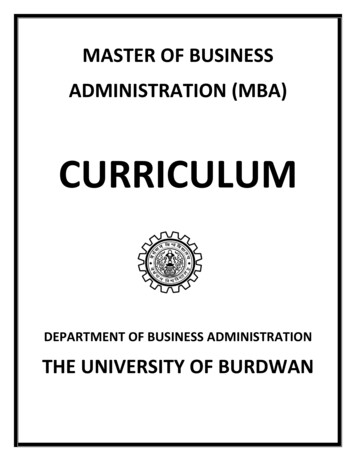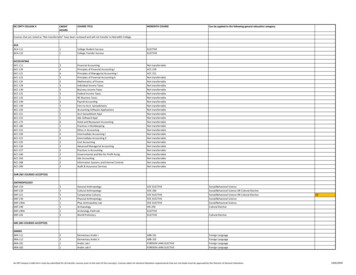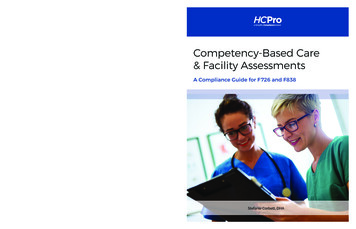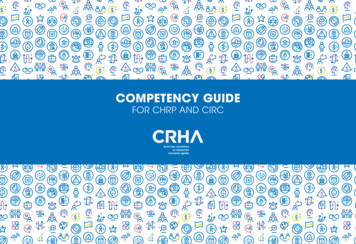
Transcription
ELECTIVE COMPETENCY AREAS, GOALS, AND OBJECTIVES FOR POSTGRADUATEYEAR ONE (PGY1) MANAGED CARE PHARMACY RESIDENCIESPrepared jointly by the American Society of Health-System Pharmacists (ASHP) and theAcademy of Managed Care Pharmacy (AMCP)IntroductionThe competency areas, goals, and objectives are to be used in conjunction with the ASHP AccreditationStandard for Postgraduate Year One (PGY1) Managed Care Pharmacy Residency Programs.Thanks to the Center for Pharmacy Practice Accreditation (CPPA) for developing accreditation standards for Specialty Pharmacy and to theUniversity of Wisconsin Health PGY2 Specialty Pharmacy Residency Program for developing goals and objectives based on CPPA’s standards fromwhich these were derived.Page 1
Competency Area E1: Specialty PharmacyGoal E1.1: Manage processes associated with enrolling patients, including assessing financialburden, into specialty pharmacy services and initiating specialty medications.Objective E1.1.1: (Analyzing) Examine current pharmacy processes for prescription benefitsinvestigation.Criteria: Identifies process for obtaining patient insurance information, group benefit design, specialtydrug utilization management restrictions, and member cost-share. Recommends potential improvements to the process for obtaining and processes memberspecific prescription benefits investigation.Objective E1.1.2: (Analyzing) Analyze the organization’s prior authorization services for clinicadministered and take-home specialty medications.Criteria: Reviews workflow for organization’s prior authorization services including initial assessment ofutilization management requirements, identifying additional clinical information required by plansponsor for review, communications to prescribers and members, and follow-up to outboundcommunications. Recommends potential end-to-end improvements in the specialty drug prior authorizationservices offered by the specialty pharmacy or health plan.Objective E1.1.3: (Evaluating) Participate in the oversight of benefits investigation and priorauthorization services.Criteria: Screens patient demographic, eligibility, benefit design, specialty drug distribution limitations andapplicable clinical information to determine suitability for specialty pharmacy services. Conducts benefits investigation and validation of insurance coverage for requested medication(i.e. submit test claims) and coordinate benefits as needed with multiple payers. Determines and applies any available and allowed specialty drug copay and financial assistance topatient specialty drug cost share. Identifies plan sponsor prior authorization requirements and needed clinical documentation andfacilitate outreach communication to prescriber. Outreaches to plan sponsor with required clinical documentation to facilitate prior authorizationapproval process.Objective E1.1.4: (Creating) Participate in the development and coordination of policies andprocedures relating to benefits investigation and prior authorization services.Criteria: Determines payer coverage and which benefit channel or site-of-care is required for medication. Determines process for outbound communications and coordination for limited distributiondrugs.Page 2
Documents workflow process for initial benefits investigations, copay and financial assistance.determination and outreach, prior authorization processes, and use of alternate specialtypharmacies for limited distribution drug distribution.Updates policies and procedures to reflect specialty pharmacy processes.Objective E1.1.5: (Understanding) Review the specialty pharmacy’s procedure for informingpatients of their financial responsibility and process for discussion with the patient when they areinitiated on a specialty pharmaceutical.Criteria: Understands process to determine patient eligibility and need for financial assistance based oninsurance restrictions, available programs and requirements, secondary insurance, and patientfinancial responsibility. Understands roles of patient care coordinator, prescriber, and patient in enrolling qualifiedpatients in financial assistance programs. Describes billing under pharmacy benefit structure or medical benefit structure as required bythe plan sponsor. Understands the significance of billing using the appropriate HCPCS codes for medical benefitbilling. Describes the process for completion of any required payer or plan sponsor reporting related topatient copay or financial assistance.Objective E1.1.6: (Understanding) Explain how the organization utilizes manufacturer sponsoredmedication assistance programs for patients with significant financial burden.Criteria: Describes resources for obtaining manufacturer sponsored copay and financial assistanceprograms. Describes patient populations ineligible for manufacturer sponsored copay and financialassistance programs. Describes the differences between manufacturer and charitable organization financial assistanceprograms and patient eligibility.Objective E1.1.7: (Evaluating) Review the policies and procedures related to patient enrollment inco-pay assistance programs.Criteria: Identifies opportunities for improvement in policies related to patient enrollment in financialassistance programs.Goal E1.2: Understand supply chain and inventory management principles and apply them tospecialty pharmacy operations.Objective E1.2.1: (Applying) Participate in the management of drug recalls and shortages inaccordance with the organization’s policies and procedures.Criteria:Page 3
Reviews the policy and procedure for drug recalls and shortages.Identifies internal and external drug recall triggers.Identifies sources of information related to drug recalls and shortages.Once a drug recall requires internal action, outlines and facilitates activation all of the necessaryactions and communications per policies and procedures.After notification of a critical drug shortage, activates an internal and external plan forcommunication per policy and procedures.Objective E1.2.2: (Understanding) Explain the acquisition, distribution and contracting processesfor specialty drugs including Limited Distribution drugs and strategy for determining competitivepricing for specialty clients.Criteria: Describes the process and requirements within the organization to contract with externalspecialty pharmacy providers for medication distribution including limited distribution drugs. Describes key elements of an agreement between a plan sponsor and specialty pharmacynecessary to ensure high quality clinical care (i.e. patient tracking, medication adherence,medication event management, phone responsiveness, patient training/counseling timelinessand effectiveness, etc.) and financial accountability. Explains the organization’s legal process for developing and executing specialty pharmacynetwork contracts.Goal E1.3: Assure compliance with the requirements regulating initial and continued specialtymedication access for the organization.Objective E1.3.1: (Understanding) Understand the impact of limited distribution drugs on thepharmacy.Criteria: Explains the rationale for pharmaceutical manufacturers to limit distribution to select specialtypharmacy providers. Describes the impact on the payer, prescriber, specialty pharmacy and patient related to limiteddistribution of specialty drugs.Objective E1.3.2: (Evaluating) Assess compliance with Risk Evaluation and Mitigation Strategy(REMS) requirements for specific medication therapies by the specialty pharmacy.Criteria: Assesses the requirements for Risk Evaluation and Mitigation Strategies (REMS) for specialtydrugs. Evaluates organization’s requirements related to REMS programs. Determines organization’s compliance with REMS requirements.Goal E1.4: Manage the utilization of external data reporting for specialty medications.Objective E1.4.1: (Understanding) Explain the process used by the organization to collect andreport data required by manufacturer or insurer contracts.Page 4
Criteria: Describes the sources of data required for reporting to manufacturer’s and/or payers. Identifies the appropriate data analytic resources (tools, personnel) to complete data reportingrequirements.Objective E1.4.2: (Analyzing) Review pharmacy data reporting provided to health plan anddetermine improvement opportunities.Criteria: Reviews clinical, patient-reported, operational, and financial data collected based on theparameters of disease state and medication, and how data is obtained from internal and externalsources. Reviews patient, internal stakeholder, and external stakeholder requirements for data reportingand structuring the format of reports to meet requirements. Analyzes and interprets clinical and patient-reported data to determine clinical and patientreported outcomes to improve patient treatment and quality of life. Analyzes and interprets operational and financial data to determine operational and financialoutcomes to evaluate the pharmacoeconomic impact of service offerings. Reports clinical, patient-reported, operational, and financial data and make improvementrecommendations to patients, internal stakeholder, and external stakeholder.Goal E1.5: Evaluate interdisciplinary specialty patient management utilizing principles of carecoordination.Objective E1.5.1: (Evaluating) Assess current practices for collaboration with non-pharmacyproviders included in the care of patients on specialty products.Criteria: Identifies health professionals involved in the care coordination for patients receiving specialtymedications. Evaluates “triggers” and process for enrollment into care management programs. Identifies desired outcomes of care management and coordination programs. Recommends improvements in the care coordination process to improve patient outcomesrelated to specialty medications.Objective E1.5.2: (Understanding) Explain the process utilized by health care providers to educatepatients being initiated on a specialty pharmaceutical.Criteria: Describes process for development of individualized education plans for specialty pharmacypatients to achieve treatment goals. Explains roles of staff related to providing education on specialty pharmacy medications.Competency Area E2: Pharmacy ResearchGoal E2.1: Conduct and analyze results of pharmacy research.Page 5
Objective E2.1.1: (Creating) Design, execute, and report results of investigations of pharmacyrelated issues.Criteria: Identifies appropriate pharmacy issues to study. Ensures associated literature search is comprehensive. Develops an appropriate research question(s) to be answered by the study investigation. Develops specific outcomes, selects an appropriate study design, and develops study methods toanswer the research question(s). Proactively seeks guidance from IRB resources (e.g., published policies and procedures, website,personal contact) prior to completing IRB proposal. Responds promptly to IRB requests for clarifications, additional information or revisions. Acts in accordance with the ethics of research on human subjects, if applicable. Appropriately collects and analyzes data. Draws valid conclusions through evaluation of the data. Effectively reports the results and creates actionable recommendations in writing. Effectively presents the results and recommendations peers and stakeholders.Objective E2.1.2: (Analyzing) Participate in prospective and retrospective clinical, humanistic, andeconomic outcomes analyses.Criteria: Applies principles and methods of basic pharmacoeconomic analyses. Uses study designs appropriate for prospective or retrospective clinical, humanistic, and/oreconomic outcomes analyses as appropriate. Collects the appropriate types of data for use in a prospective or retrospective clinical,humanistic, and/or economic outcomes analysis as appropriate. Uses reliable sources of data for a clinical, humanistic, and/or economic outcomes analysis. Uses appropriate methods for analyzing data in a prospective and retrospective clinical,humanistic, and/or economic outcomes analysis. Applies results of a prospective or retrospective clinical, humanistic, and/or economic outcomesanalysis to internal business decisions and modifications to a customer's formulary or benefitdesign as appropriate. Considers the impact of limitations of retrospective data on the interpretation of results.Competency Area E3: Added Leadership and Practice Management SkillsGoal E3.1: Apply leadership and practice management skills to contribute to management ofpharmacy services.Objective E3.1.1: (Applying) Manage the use of investigational drug products (medications, devices,and biologicals).Criteria: Describes and observes regulatory requirements. Observes established protocols and the organization’s policies and procedures. Participates in monitoring activities of involved study sponsors. Prepares and dispenses medications, devices, and biologicals according to the organization’spolicies and procedures.Page 6
Assists with processes to develop and educate staff regarding on-going protocols and theirrelated distribution systems.Ensures compliance with relevant regulations.Objective E3.1.2: (Applying) Contribute to the financial management of the department.Criteria: Participates in development of an operating (e.g. medication class impact on drug spend, FTE,non-employee expenses) or capital budget (e.g. software and technology upgrades, programs,expansion of department). Participates in the evaluation of pharmacy budget monitoring reports. Participates in the development of cost reduction strategies and revenue capture and recovery. Participates in revenue management and reimbursement for products (e.g. contracting withpharmaceutical companies, rebates) and services in the department. Ensures compliance with relevant regulations. Participates in the development and monitoring of a client contract. Participates in the development of a request for proposal (RFP).Objective E3.1.3: (Applying) Contribute to the development of a new pharmacy service or to theenhancement of an existing service.Criteria: Accurately assesses current pharmacy service or program to determine if it meets the statedgoals. Identifies need(s) that may exist. Makes contributions to a proposal for a new service, or enhancement of existing services thatclearly describes the service or enhancement, the role of different health care providers in theservice/enhancement, predicts financial outcome(s) and system and human resources needs. Plans effectively for implementation and utilization of the new or enhanced service. Demonstrates understanding of the relevance of the existence and use of evidence-basedtreatment guidelines/protocols in the managed care environment. Effectively selects metrics for evaluation, such as humanistic and economic outcomes, whenapplicable. Appropriately interprets existing quality and/or safety metrics data, when applicable. Develops and presents business plan to pharmacy and organizational leadership, whenapplicable.Objective E3.1.4: (Analyzing) Effectively manage ongoing operational functions of the service.Criteria: Effectively manages patient appointment lengths and space needs. Effectively utilizes EMR technology to maintain efficient documentation, alerts, and referralprocesses. Effectively maintains the established system for securing service supplies (e.g., patient educationmaterials, supplies). Effectively implements plans for the ongoing marketing of the service including the recruitmentof patients. Effectively applies the principles of performance improvement to the ongoing functions of theservice. Effectively solves problems arising in the operation of the service, such as when demand exceedsstaffing, when resources are not sufficient, and managing peaks in workflow. Effectively contributes to strategic planning for the service and/or practice.Page 7
Effectively participates in orienting new staff and other trainees.Effectively selects factors for evaluation, such as humanistic and economic outcomes.Objective E3.1.5: (Creating) Assure that the service operates in accord with legal and regulatoryrequirements.Criteria: Demonstrates understanding of relevant legal and regulatory requirements. Takes effective action to ensure compliance with requirements. Effectively maintains legal coding and billing activities. Maintains applicable certifications and training requirements.Goal E3.2: Contribute to the management and development of pharmacy staff.Objective E3.2.1: (Applying) Contribute to recruitment for specified positions.Criteria: Determines responsibilities and qualifications of a specified position. Applies appropriate advertising approach for a position to be filled (e.g., internally versusexternally). Includes appropriate information in recruitment materials for a position. Considers appropriate skills, traits, abilities and characteristics when determining the individual'squalifications for a position. Considers appropriate skills, traits, abilities and characteristics when deciding to hire internallyversus externally. Considers the organization's policy regarding equal employment opportunity and affirmativeaction. Considers requirements of the American Disabilities Act on interviews. Applies appropriate organizational and department processes to interview and recommendpersonnel for employment. Effectively evaluates cover letters and resume or curriculum vitae to determine whom tointerview. Determines appropriate content and format for interview questions. Determines with whom candidates should interview. Determines how to select candidates to interview. Makes appropriate use of references. Includes appropriate information in an offer letter. Ensures compliance with relevant regulations.Objective E3.2.2: (Applying) Contribute to orientation, staff development, and training activities forpractice area personnel.Criteria: States the purposes of orientation, staff development, and training. States the roles of the organization and of the practice area in orientation, staff development,and training. Assists with analysis to determine staff development and training needs. Uses data from development analysis to develop gap analysis. Effectively assists with program development. Evaluates program effectiveness. Effectively helps determine what subjects should be covered in orientation and time needed foradequate coverage.Page 8
Effectively helps determine subjects that should be covered in training for a specific position andtime needed for adequate coverage.Helps determine and implement effective methods for ensuring that a new employee issufficiently trained for his or her position.Explains the impact of the Family Medical Leave Act and union contract on human resourcespolicy.Describes the organization's probationary period.Objective E3.2.3: (Understanding) Explain the components of an employee performance evaluationsystem.Criteria: Coaches effective methods for writing a self-evaluation. States the performance standards for a specific position. States effective methods for communicating performance standards and evaluation ofperformance to employees. Explains effective ways to measure work against objective and subjective performance standards. Ensures compliance with relevant regulations.Objective E3.2.4: (Understanding) Explain the principles and application of a progressive disciplineprocess.Criteria: Explains the components of the progressive discipline process. States the benefits of the progressive discipline process to the employer and the employee. Ensures compliance with relevant regulations.Goal E3.3: Understand the process of establishing a pharmacy residency program.Objective E3.3.1: (Understanding) Explain the steps involved in establishing a pharmacy residencyprogram at a particular site.Criteria: Explains the sources of published information to be used when establishing a residency program(e.g., accreditation regulations, accreditation standards, ASHP website).Competency Area E4: Home Care Medication ManagementGoal E4.1: Understand home care services that can be provided to meet the needs of homecare patients.Objective E4.1.1: (Understanding) Explain the scope of home care services that are available forhome care patients.Criteria: Identifies health care needs of typical home care patients and describes the scope of servicesavailable to meet these needs. Identifies the various service models available to meet the pharmaceutical care needs of typicalhome care patients (e.g., by health systems, stand-alone organizations, and other provider typesthat service home care patients).Page 9
Objective E4.1.2: (Understanding) Explain those aspects of providing evidence-based, pharmacistcare process (JCPP) with interdisciplinary teams that are unique to the home care environment.Criteria: Explains the rights and responsibilities of a home care patient. Explains strategies for getting information from unwilling or unavailable participants. Explains additional concerns with compliance, cost, and routes of administration, and medicationdevices when making decisions on medication regimens for home care patients. Explains how to determine whether the first dose and subsequent doses of medication ortherapy should be administered at home or in a controlled-care setting and incorporates this intothe patient’s care plan. States customary monitoring parameters for the effects of the use of access and administrationdevices and incorporates these into the care process. Selects appropriate supplies for the patient’s method of administration, vascular access deviceand medication. Explains appropriate techniques to care for the typical types of vascular access devices used inhome care. Explains procedures for administering medications and nutritional therapies used in the homecare environment. Explains procedures for managing complications resulting from the administration of medicationsand nutritional therapies typically provided in home care.Objective E4.1.3: (Applying) Provides effective patient care and education in the home careenvironment.Criteria: Establishes a caring relationship with patient as appropriate to the home care setting and stage inthe patient’s health care management. Determines the patient’s social determinants of health (e.g. primary spoken language, healthliteracy, cultural and sensory deficits (e.g. sight, hearing). Assesses the patient’s knowledge about his or her health problems and medications, physical andmental capability to use the medications appropriately, attitude toward the health problems andmedications and ability to implement the medication plan in the home. Provides information orally and uses visual aids or demonstrations to fill patients’ gaps inknowledge and understanding as appropriate to the home care environment. Ensures appropriate storage and security of medications in the home. Verifies patients’ knowledge and understanding of medication use. Addresses barriers to optimal medication management which are common with home carepatients. Works with an interdisciplinary team, including providers, home care nurses, social workers, carecoordinators, and caregivers to implement medication changes and follow up with patients.Objective E4.1.4: (Analyzing) Collect and organize all patient-specific information needed by thehome care pharmacist to determine the suitability for pharmacist to attend home visit.Criteria: Identifies the types of information used by the home care provider team, including thepharmacist, to determine the suitability of individual patients for each of the typical home careservices provided by the organization.P a g e 10
Competency Area E5: Teaching and Learning for programs associated withteaching certificateGoal E5.1: Demonstrate foundational knowledge of teaching, learning, and assessment inhealthcare education.Objective E5.1.1: (Understanding) Explain strategies and interventions for teaching, learning, andassessment in healthcare education.Criteria: Accurately differentiates teaching and learning. Discusses appropriate teaching strategies for learning environments, including small and largegroup, didactic and experiential. Describes various teaching approaches and benefits for different learning styles. Characterizes assessment tools available for learning environments.Objective E5.1.2: (Understanding) Explain academic roles and associated issues.Criteria: Resident discusses and explains:o the role of a course syllabus;o the importance of academic honesty;o the importance of professionalism in academia;o the role of accreditation (ACPE), professional organizations (AACP) and Center for theAdvancement of Pharmacy Education (CAPE) Outcomes on pharmacy curricula; and,o faculty roles and responsibilities, including academic rank and promotion, and relationshipbetween teaching, scholarship, and service.Goal E5.2: Develops and practices a philosophy of teaching.Objective E5.2.1: (Creating) Develop a teaching philosophy statement.Criteria: Teaching philosophy includes:o self-reflection on personal beliefs about teaching and learning;o identification of attitudes, values, and beliefs about teaching and learning; and,o illustrates personal beliefs on practice and how these beliefs and experiences are incorporatedin a classroom or experiential setting with trainees.Objective E5.2.2: (Creating) Prepare a practice-based teaching activity.Criteria: Develops learning objectives using active verbs and measureable outcomes. Plans teaching strategies appropriate for the learning objectives. Uses materials that are appropriate for the target audience. Organizes teaching materials logically. Plans relevant assessment techniques. When used, develops examination questions that are logical, well-written, and test the learners’knowledge rather than their test-taking abilities. Participates in a systematic evaluation of assessment strategies (e.g., post-exam statisticalanalysis) when appropriate. Ensures activity is consistent with learning objectives in course syllabus.P a g e 11
Objective E5.2.3: (Applying) Deliver a practice-based educational activity, including didactic orexperiential teaching, or facilitation.Criteria: Incorporates at least one active learning strategy in didactic experiences appropriate for thetopic. Uses effective skills in facilitating small and large groups. For experiential activities:o organizes student activities (e.g., student calendar);o effectively facilitates topic discussions and learning activities within the allotted time;o effectively develops and evaluates learner assignments (e.g., journal clubs, presentations,SOAP notes;o effectively assesses student performance; and,o provides constructive feedback.Objective E5.2.4: (Creating) Effectively documents one’s teaching philosophy, skills, andexperiences in a teaching portfolio.Criteria: Portfolio includes:o a statement describing one’s teaching philosophy;o curriculum vitae;o teaching materials including slides and other handouts for each teaching experience;o documented self-reflections on one’s teaching experiences and skills, including strengths,areas for improvement, and plans for working on the areas for improvement;o peer/faculty evaluations; and,o student/learner evaluations.Competency Area E6: Health and Wellness ProgrammingGoal E6.1: Design and deliver programs that contribute to public health efforts.Objective E6.1.1: (Creating) Design and deliver programs for health care consumers (e.g.employers, health plans, patient groups) that center on disease prevention and wellnesspromotion.Criteria: Identifies target audiences for disease prevention and wellness promotion and the relativepriority of programming for each of these audiences. Uses the data required to justify a program. Identifies and provides the support needed to establish a program. Identifies and manages problems and shortcomings associated with the maintenance of awellness promotion program.Approved by the ASHP Commission on Credentialing on August 12, 2018. Endorsed by the ASHPBoard of Directors on September 28, 2018. Developed by the ASHP Commission on Credentialing incollaboration with the Academy of Managed Care Pharmacy (AMCP).Copyright Year 2018, American Society of Health-System Pharmacists, Inc. All rights reserved.P a g e 12
Evaluates organization's requirements related to REMS programs. Determines organization's compliance with REMS requirements . Goal E1.4: Manage the utilization of external data reporting for specialty medications. Objective E1.4.1: (Understanding) Explain the process used by the organization to collect and
